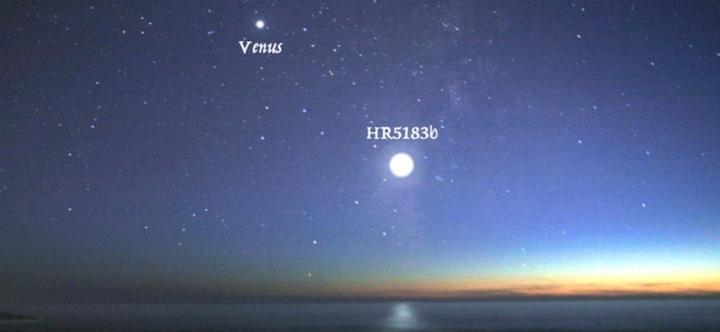7.11.2019

Contrary to previous thought, a gigantic planet in wild orbit does not preclude the presence of an Earth-like planet in the same solar system – or life on that planet.
What’s more, the view from that Earth-like planet as its giant neighbor moves past would be unlike anything it is possible to view in our own night skies on Earth, according to new research led by Stephen Kane, associate professor of planetary astrophysics at UC Riverside.
The research was carried out in the backdrop of a planetary system called HR 5183, which is about 103 light years away in the constellation of Virgo. It was there that an eccentric giant planet was discovered earlier this year.

Comparison of HR 5183b's eccentric orbit to the more circular orbits of the planets in our own solar system. (W. M. Keck Observatory/Adam Makarenko)
Normally, planets orbit their stars on a trajectory that is more or less circular. Astronomers believe large planets in stable, circular orbits around our sun, like Jupiter, shield us from space objectsthat would otherwise slam into Earth.
Sometimes, planets pass too close to each other and knock one another off course. This can result in a planet with an elliptical or “eccentric” orbit. Conventional wisdom says that a giant planet in eccentric orbit is like a wrecking ball for its planetary neighbors, making them unstable, upsetting weather systems, and reducing or eliminating the likelihood of life existing on them.
Questioning this assumption, Kane and Caltech astronomer Sarah Blunt tested the stability of an Earth-like planet in the HR 5183 solar system. Their modeling work is documented in a paper newly published in the Astronomical Journal.
Kane and Blunt calculated the giant planet’s gravitational pull on an Earth analog as they both orbited their star. “In these simulations, the giant planet often had a catastrophic effect on the Earth twin, in many cases throwing it out of the solar system entirely,” Kane said.
“But in certain parts of the planetary system, the gravitational effect of the giant planet is remarkably small enough to allow the Earth-like planet to remain in a stable orbit.”
The team found that the smaller, terrestrial planet has the best chance of remaining stable within an area of the solar system called the habitable zone — which is the territory around a star that is warm enough to allow for liquid-water oceans on a planet.
These findings not only increase the number of places where life might exist in the solar system described in this study — they increase the number of places in the universe that could potentially host life as we know it.
This is also an exciting development for people who simply love stargazing. HR 5813b, the eccentric giant in Kane’s most recent study, takes nearly 75 years to orbit its star. But the moment this giant finally swings past its smaller neighbor would be a breathtaking, once-in-a-lifetime event.
“When the giant is at its closest approach to the Earth-like planet, it would be fifteen times brighter than Venus — one of the brightest objects visible with the naked eye,” said Kane. “It would dominate the night sky.”
Going forward, Kane and his colleagues will continue studying planetary systems like HR 5183. They’re currently using data from NASA's Transiting Exoplanet Survey Satellite and the Keck Observatories in Hawaii to discover new planets, and examine the diversity of conditions under which potentially habitable planets could exist and thrive.
Quelle: UNIVERSITY OF CALIFORNIA, RIVERSIDE
